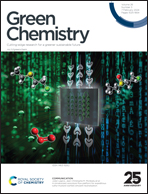Driving the rapid regeneration of LiFePO4 from spent lithium-ion batteries through one-pot mechanochemical activation†
Abstract
The recycling of spent lithium-ion batteries (LIBs) is an effectual strategy for mitigating environmental and resource crises. Lithium iron phosphate batteries, renowned for their unique safety and stability, are widely utilized in energy storage systems and electric vehicles, consequently resulting in a growing number of spent LIBs. Herein, a one-pot mechanochemical process that integrates the recycling and preparation of LiFePO4 is proposed to drive the rapid regeneration of spent LiFePO4. Benefiting from the inherent characteristics of the input material, more than 98% of Li is selectively released, while less than 1.5% of Fe is leached without any impurity output. To this end, these reclaimed precursors in a ball mill can be directly re-used for the regeneration of LiFePO4 with an appropriate lithium source addition, eliminating the need to recover LiFePO4 with various degrees of lithium deficiency. As expected, the regenerated LiFePO4 delivers a discharge specific capacity of 143 mA h g−1 without negligible capacity fading after 250 cycles at 1 C, featuring significantly improved rate capability and long-term cycling stability. Designed with sustainable, integrated, and close-loop operation routes, this process pioneers a novel strategy to scale up the direct recycling for the LiFePO4 cathode.



 Please wait while we load your content...
Please wait while we load your content...